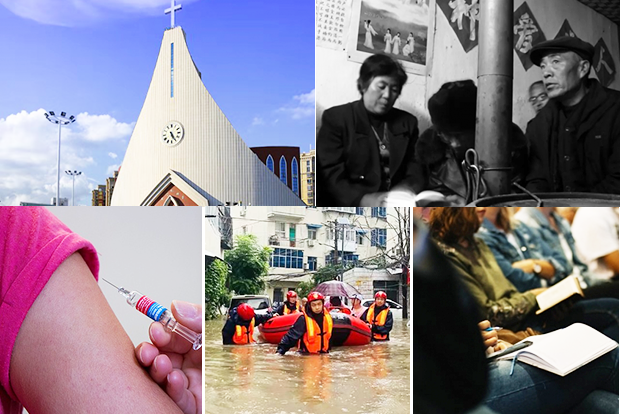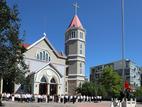2021 was deemed as being in the post-pandemic era after 2020, a year full of fantasy and authenticity due to the COVID-19 pandemic which would have a profound impact on the world and human history.
Registered churches or TSPM churches encountered sudden lockdowns and reopening from time to time according to local pandemic rebounds and de-escalations, while house churches were restricted from having large gatherings and instead met online. Easter and Christmas were celebrated in a low key fashion. The campaign for the sinicization of Christianity remained ongoing in official churches. Church leaders were seeking new ways to renovate ecclesiology and to pastor their congregations during the strange period.
Natural disasters struck China’s Henan, Shanxi, and Sichuan Province. Christians in China came to aid the affected churches, believers, and residents with donations, supplies, and other daily services.
Specific laws and regulations on cyberspace in religion, religious institutions, and religious personnel were released. Live streaming seminars and workshops became popular within academia.
As we embrace 2022, the editorial team of China Christian Daily has selected the top 10 Christian news stories of 2021 based on the number of views, keyword searches, shares, and prominence of articles.
Below is part 1, Nos. 1-5 of CCD'S top 10 news stories of 2021. Read part 2 of CCD's top 5 news stories of the year here.
1. The routine of the Chinese church under the pandemic: abrupt closure and reopening, and restrictions
Since the COVID-19 outbreak in Wuhan on January 23, 2021, local rebounds struck different provinces, causing regional churches to be in lockdown, particularly government-sanctioned churches which were commanded to obey the local pandemic prevention and control policies. In early 2021, positive COVID-19 cases throve in Shijiazhuang, Hebei, causing official churches in the whole province to suspend all in-person services and gatherings. New locally transmitted infections raged Shanxi, Shanghai, and Jilin, forcing many churches to meet online. The majority of registered churches in other provinces including Anhui and Sichuan were closed down around the time of Chinese New Year, a period when the largest portion of the population travel back to their hometowns, in order to avoid mass transportation of the virus.
As the local epidemic receded, the once closed churches started to reopen at the end of February. Beijng, Shanghai, Anhui, Jiangsu, Zhejiang, Sichuan, and Liaoning, gradually resumed on-site gatherings in March. TSPM churches in other provinces like Guangxi and Shaanxi followed on Palm Sunday. Easter had been largely celebrated throughout China since the recent mass reopening.
Abrupt closures occurred amid resurgences of COVID-19 cases in several areas, for instance, Guangdong and Fujian. The good news of reopening came again in July and August with the de-escalation of the COVID-19 pandemic, but the situation did not last long as the second wave of infections rose as well. Such a pattern ran in a cycle from time to time until the end of last year.
Meanwhile, house churches, generally considered illegal, enjoyed more freedom in meeting together, but some of them faced restrictions and shutdowns under the pressure of local authorities due to “mass gatherings” or other unknown reasons. A portion of family churches were divided into small groups who gathered at private homes of their own will or by force.
Christmas, one of the peaks in the calendar of the Chinese church, was celebrated in a low key way under COVID-19 restriction rebounds. Hybrid celebrations were conducted in-person, with attendance limitations, and virtually. Some chose to celebrate the birth of Jesus Christ in advance to avoid any “unexpected shutdown” due to any possible virus wave. Large gatherings or evangelistic meetings were canceled. Anti-Christmas voices were spoken out in specific regions, like a county in China’s southern Guangxi Province which was said to forbid local schools from observing the “foreign festival” that “were the transplant of western values and lifestyles into the country by developed countries in the West through advanced technology and cultural communication”.
2. The source Shijiazhuang outbreak was said to be found a direct link with religious gatherings.
All the local registered places of worship in Hebei’s capital Shijiazhuang were shut down and all religious activities suspended on January 7 immediately after the city saw 31 confirmed patients as of January 8, according to the Health Commission of Hebei. Rumors circulated online saying that “priests from Europe and the US preached in the district” and religious people attended a group activity in a villager’s house, which directly caused the cluster.
A day before the sudden closure, the Patriotic Catholic Association of a local district publicly denounced the rumors that Catholics caused the pandemic to spread in the city. The Chinese Patriotic Catholic Association and Chinese Catholic Bishops College issued a document supporting the claim the next day. On the same day, local authorities claimed that there was no evidence suggesting any direct connection of religious gatherings with the latest COVID-19 spike in Gaocheng District where there were 122 Christians in Xiaoguozhuang Village with a population of 4721, refuting the claim of the village being primarily Catholic. Global Times, the Chinese Communist Party's flagship English newspaper, also published an article to confirm that there was no evidence proving such connection.
A grass-roots Protestant church pastor urged Christians to pray for them as there was no live virtual preaching as no network connectivity was installed in his home. He requested intercessory prayers for the prevention and control of the pandemic, for health workers, and for the spiritual life of believers, while another pastor in downtown Shijiazhuang, far away from the infected area, responded that everything was fine.
A scholar expressed his opinion to the public that those “negative rumors against the group should not be made out of nothing or discrediting religions". A media professional said that the self-media hyped the religious activities taking place in rural areas of Shijiazhuang. He refuted the rumors by inferring that the religious villagers were mainly Protestant, adding that the generally-biased public discourse on rural, elderly residents and on Christianity contributed to the groundless allegation.
3. Only vaccinated Christians were allowed to enter churches in some cases.
A Fujian TSPM church said in August that only attendees who had been vaccinated against coronavirus or who hold a PCR negative test result would be allowed to enter after a temperature check. Masks and social distancing are also compulsory inside the building of Chengguan Church in Pingtan, Fuzhou.
The same rule was also applied to Yanjiao Church in Sanhe City, Hebei Province. On June 27, only around 50 vaccinated believers were permitted to attend morning services under real-name management.It was said that a megachurch in Beijing collected the statistics on the number of vaccinated members.
What was more, people had to register and fill in their personal information before entering a registered church, in some cases.
4. Churches across China were engaged in disaster relief and other charities.
The Christian community in China continued to live out the Great Commandment of “loving your neighbor as yourself” and God’s mercy in different needs. Torrential storms and floods ravaged the Henan Province in mid-July as some cities were “soaked in water”. The faith-based Amity Foundation initiated disaster relief immediately, sending supplies to the affected regions. Official and unofficial churches both prayed, donated funds and supplies to the vulnerable people, and came to the frontline to rescue the victims there.
A magnitude 6.0 earthquake struck Sichuan Province in mid-September, causing damage to some local churches and believers’ homes to varying degrees. A relief team was set up by the Christian community to provide first-hand aid.
Many rural churches in Shanxi Province were damaged by continuous heavy rainfall which caused floods in October and some even suffered from leaks and collapse. Apart from financial support, church members delivered meals to relief workers, while the staff visited the affected churches and believers in the flooded areas.
Christian-initiated charities in China were also active in the "99 Giving Day" in September to raise funds, China's largest annual online charity campaign. YMCA was involved in the campaign for projects for people with mental disorders and the Amity Foundation for special children. A Christian charity worker who has been devoted to caring for sick children suffering from serious illnesses said that he felt inspired to see many people, Christians or non-Christians, came to support his work during the fundraising event.
For the first time, a church in Sichuan Province was designated as a vaccination site to assist local medical work. Donations, voluntary work, and materials poured into different provinces in the national anti-pandemic fight.
5. Ecclesiology and the concept of pastoring were renovated in the post-pandemic era.
Grass-roots pastors were reflecting ecclesiology and renovating the concept of pastoring in the post-pandemic era. A senior pastor who serves migrant workers in East China claimed that churches in the post-pandemic era needed to shift from the main Sunday gathering mode to the mode of online, group, and family worship. He added that congregations must upgrade the concept of “gathering in church buildings for Sunday services”, which was formed in the past decade, a mainstream concept which he found was the hardest one to change.
A large portion of pastors shared their new insights into ecclesiology that they were against temple-centralism rather than gathering in church buildings as “the model initiated by Jesus is the model of the free union of Christians, which is unlimited in number and gender”. “It can be two or three people or more than a dozen.”
A young pastor stated that churches should walk out of the pursuit of large-scale transformation and institutionalization. The two important tasks at present were to train fellow workers and to strengthen believers with God’s word. A middle-aged pastor in the central region urged churches to renovate their concept of pastoring: changing from the “religious” ministry model to establishing personal relationships with God; the pastoral role shifting from a leader into a lighter; the true mission field lying in the world rather than the church alone; pastors seeking the depth of their spirituality instead of external scale.
The church also explored other practical ways to nurture its flock, such as meeting in small groups and pastoring them in divided teams. The visitation ministry was vigorous to connect church members during the lockdown due to COVID-19. More concerns should be paid to how to give play to the function of the laity.
Karen Luo, Ruth Wang, and Grace Zhi contributed to these reports











